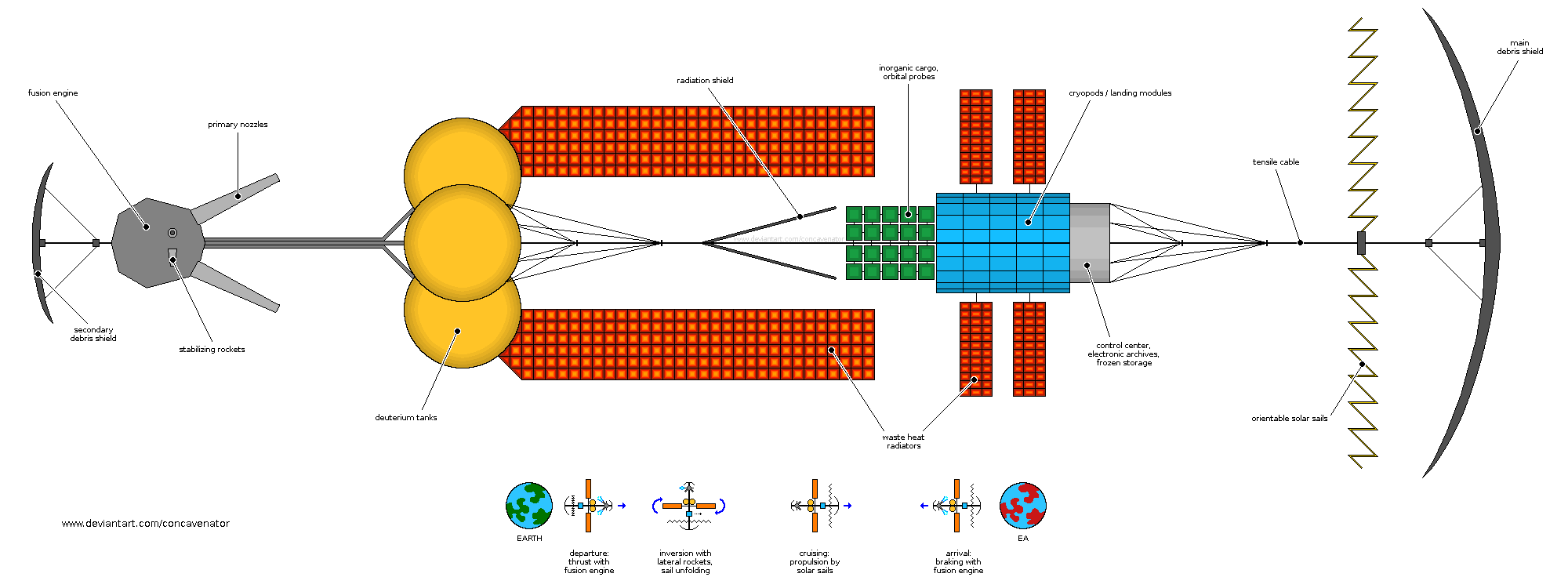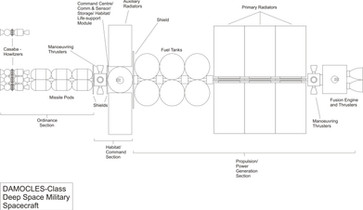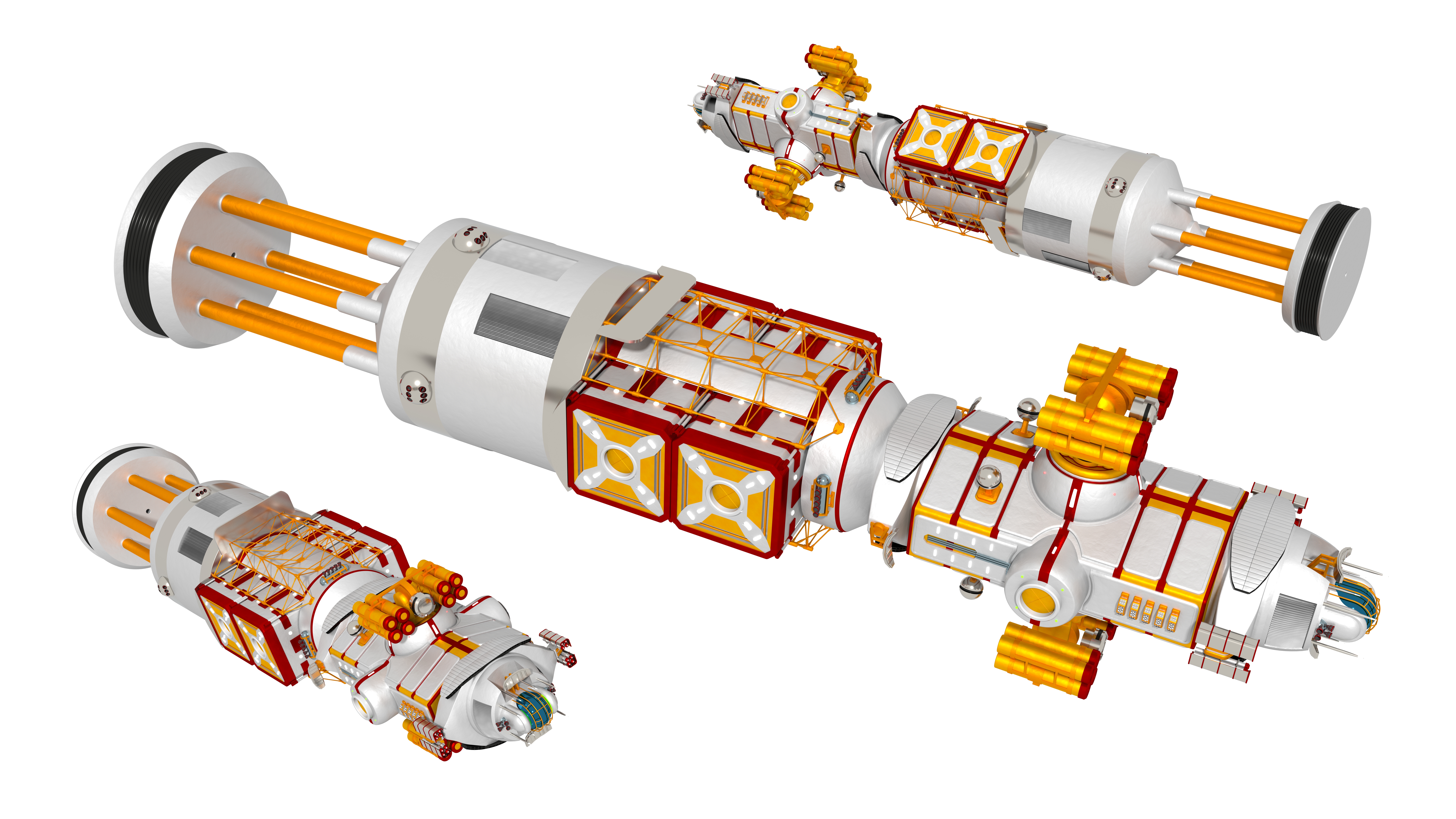HOME | DD
 Concavenator — Ea: UNSS Utnapishtim
Concavenator — Ea: UNSS Utnapishtim

#spacecraft #starship
Published: 2019-01-08 00:56:41 +0000 UTC; Views: 3997; Favourites: 31; Downloads: 0
Redirect to original
Description
A simplified schematic drawing of the UNSS Utnapishtim, the starship that brought humanity to Ea, leaving Earth in 2070 . It was assembled in Earth's geostationary orbit between 2062 and 2068 from surface-built pieces, and accessed by its 10,000 occupants via single-stage surface-to-orbit rockets. The ship did not have, at departure, a particular target: it was meant to wander from star to star until its automated system detect a planet suitable for human life.(Meet its commander as well, Arslana Samirowa ).
STRUCTURE
The front shield protects the rest of the ship from impacts with high-velocity debris and interstellar medium. (A secondary shield at the opposite end protects the ship during the brief period in which it moves backward.) Immediately behind, orientable photon sails, which measure several kilometers of length when fully extended, are the main source of movement. These use the energy from photons to provide acceleration without expelling reaction mass, thus reducing greatly the mass of the ship; the thrust is not very powerful, especially in interstellar space, but it can be applied continuously during the travel, to the point of reaching a significant fraction of the speed of light. This is critical, as the Utnapishtim's mission does not have a definite length, and it wouldn't be possible to calculate a definite amount of propellant for the entire voyage.
At the opposite end of the ship, a nuclear engine (fusing deuterium into helium) provides a vastly more powerful but brief thrust at two key point: departure from Earth's orbit and braking in Ea's system (see the flight diagram below). As the ship departs, it points its main shield toward the Earth, so that the fusion engine accelerates it backward into space. The nozzles are pointed forward, angled 20° away from the ship's axis so that the exhaust does not damage the other structures without sacrificing too much thrusting efficiency. At this point, the fusion engine turns off, the ship rotates with its main shield forward (thanks to the lateral rockets, combined with the release of ballast from the cargo area), and unfolds the solar sails. When the ship is near its destination, the main nozzles fire again to brake. The lateral rockets, powered by the same fusion engine, also make the ship spin on its axis at a regular speed to stabilize its direction; they also help changing course. The Utnapishtim's specialized AI decides the orientation and power of the micro-thrusts.
Note that, at any point of the voyage, the ship is never pushed but only pulled. Than means that, instead of a rigid frame, the components can be connected by a cable of twisted carbon nanotubes, which makes the overall structure much lighter, while keeping the cargo sections well distanced from the source of radiation in the engine. A third shield also protects the cargo area; because of its high angle, it reflects the radiations off into space rather than toward the engine, to avoid additional strain to the latter's shielding. Enormous radiators shed the excess heat produced by the nuclear reaction; normally they would point out, perpendicularly to the ship's body, to avoid radiating the heat back onto its components.
The central portion of the ship contains the cargo, including prefabricated machinery, frozen biological samples, and the 10,000 people under cryoconservation. Smaller radiators shed heat from the processes that keep the cryopods and the electronic systems working. The human-cargo section is composed by 100 connected modules, each with 100 occupants, which will detach from the cable and descend on Ea's surface. The section in the front contains the frozen biological samples, the memory of the digital archive, the mainframe of the ship's AI, and most of the sensors. Each detected planet is analyzed for gravity (from its orbital mechanics), surface temperature, and atmospheric chemistry (from spectroscopy).
(basic information from Winchell Chung's Atomic Rockets , any mistake or implausibility is on me)
CARGO
Human occupants
- 5000 "general purpose laborers" (for unspecialized manual work, starting breeding population)
- 1800 scientific personnel, including astrophysicists, geologists, geochemists, ecologists, biochemists, microbiologists, zoologists and botanicists, sociopsychologists, etc.
- 1200 technical personnel, including agricultural botanicists, biotechnologists, engineers, computer technicians, laboratory technicians, heavy machinery specialists, etc.
- 1000 starship personnel, including navigators, security officers, cryoconservation specialists, archive curators, etc. (on Ea they merge into either general workers or technical personnel)
- 700 counselors and advisors, including mining and farming experts, spiritual counselors, human resource managers and organizers, wilderness survival advisors, etc.
- 300 medical personnel, including general physicians and surgeons, obstetrician-gynecologists, psychiatrists, veterinarians, etc.
Biological samples (see a detailed list )
- soil samples, containing bacteria, protists, nematodes, tardigrades, earthworms, micorrhizae, etc.
- various edible fungi (e.g. Fusarium) and algae (e.g. Porphyra)
- a variety of common insects, including mayflies, crickets, honeybees, moths, etc.
- hardy or fast-growing plants (e.g. moss and lichens, heather, acacias, bamboo, pine trees)
- common crops (e.g. rice, maize, potatoes, quinoa), various fruit and vegetables (mostly as frozen seeds)
- aquacolture species (e.g. clams, river shrimps, carps, tilapias) (mostly frozen eggs and embryos)
- larger birds (e.g. pigeons, chickens) and mammals (e.g. pigs, cattle, dogs) (as frozen embryos)
Digital archives
- main religious and philosophical texts (e.g. Bible, Qur'an, Book of Mormon, Analects, Plato's dialogues)
- books of the Western Canon, Chinese Classics, myths and legends, and similar literature
- collections of newspapers, speeches, and other historical documents
- popular books, movies, videogames, and other media
- 2D or 3D scans of significant artworks and architecture
- textbooks on Earth history and geography, physics, chemistry, biology, medicine, etc.
- technical handbooks and reference texts
Machinery (compare Open Source Ecology )
- agricultural: algal tanks, farming racks, well rigs, ovens, tractors with seeders, rakes, harvesters, etc.
- construction: earth compressors, cement mixers, bulldozers, inflatable hab modules, air miners, bioplastic generators, etc.
- industry: smelting furnaces, pipe and wire mills, saws, drills, forges, laser cutters, circuit printers, looms, etc.
- energy: radioisotope generators, solar collectors and cells, electric motors and generators, steam engines, wind turbines, batteries, hydraulic pumps, etc.
- other: 3D printers and scanners, multipurpose robot arms, rovers, balloons, incubators, etc.
EDIT 23-09-20: modified the posterior part, added secondary shield, retouched colors, modified some details of the description.

























